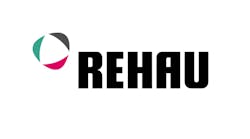J. B. Hunt, one of the largest trucking companies in North America, takes transportation seriously. Their reputation for safety and efficiency played into a decision they made in 2006 to install an extensive snowmelt system for their new headquarters building in Lowell, Ark.
The 22,000-sq.-ft. snowmelt system has been hard at work for the trucking firm for the past two winters, easily dealing with the rigors of Midwestern ice and snow. Yet, in a sad irony that hit them hard, founder Johnnie Bryant Hunt slipped on ice at a nearby restaurant in early December 2006 and died in the hospital five days later. Had the restaurant installed a snowmelt system to protect its patrons, perhaps he'd be alive today.
It was the firm's corporate vision that prompted the extensive snow- and ice-free zone outside their new headquarters, a five-story office addition that effectively doubled the size of their office space.
Today, the large circular driveway, sidewalks and entryway are easy to navigate all winter long. Customers and employees alike now enjoy safe passage to and from the building even when ice and snow accumulate just inches beyond the melt zone.
Miles of PEX
The largest part of the snowmelt system lies under a bed of asphalt. Just below it, 32,000 lineal ft. of ¾-in. RadiantPEX (e PEX b) tubing from Watts Radiant carries a heated 50/50 glycol solution to and from a large plate-to-plate heat exchanger connected to a 2,500 MBH, gas-fired Bryan steel tube boiler.
To get an idea of the size and scope of the immense snowmelt system that serves as the entry point into J.B. Hunt's brick headquarters facility, picture a circular asphalt belt, 50 ft. wide and 360 ft. in circumference. It has a center opening and a network of connected sidewalks, also snow-melted.
The 11-zone hydronic system has a liquid volume of almost 1,000 gallons and requires 175 GPM to accomplish the mission of melting snow and ice before it has time to accumulate. During times of winter precipitation, only a gentle mist is seen by the most observant person, evidence of the warm solution below heating the hard surfaces above to just 35°F, sufficient to keep surfaces clear.
“Radiant systems — and particularly large snowmelt systems like this one — typically have low return water temperatures which are a challenge for long-term boiler operation,” said Cary Pestel, president of Boone and Boone Sales Co. Inc., a manufacturer's rep firm based in Tulsa, Okla. “So we recommended that a bypass mix loop be installed that allows some of the supply water to mix to the return side of the boiler; this holds the returning water temperatures high enough to keep the boiler from condensing. The boiler we chose was ideal because of its ability to take a thermal ‘punch’ in stride.”
Installing the system required the work of a team of technicians from Fort Smith, Ark.-based Action Inc., a 160-employee mechanical contracting firm that won the installation contract.
“Though we hadn't installed a snowmelt system previously, we've completed many radiant heat projects and have a passion for large-scale hydronic systems,” said Ron Wright, vice president of the firm. “The snowmelt project at J.B. Hunt was a challenge that we enjoyed.”
Gerald Jewett, Action's jobsite supervisor, said he had three or four guys on the jobsite for several weeks.
“Most of the PEX loops were about 400 ft. long, and we decided to use 2-ft. zip ties to make all the connections to the reinforcing wire grid, so we really needed a team of at least four workmen to keep the job moving steadily.”
Due to the large scope of the project, it was initially designed using Watts Radiant's Onix hose. Later budget constraints caused it to be re-designed using ¾-in. Epex-B. The PEX was laid under an 8-in. to 10-in. layer of chat.
Action Mechanical installed the pipe, then pushed the chat over the top of the PEX, working carefully not to drive across it. The concern was that the heavy equipment would crush the pipe if it was subjected to the direct weight of the vehicle.
By pushing the chat over the top of the PEX, Action was able to drive on the covered PEX because the stone dust effectively distributed the weight of the vehicles over a wider area.
Once the PEX was laid and the chat filled over the top, a 4-in. layer of asphalt was added. The system was designed as a reverse return system with one large circulation pump. Bell & Gossett's Circuit Sentry auto balance valves were used to control flow at each of the manifold locations.
Though the “heart” of the system may be the commercial boiler, it's the large, skid-mounted HydroControl package built for the job by Watts Radiant that serves as the “brain” and “pulmonary system.”
The HydroControl quietly performs its duty from within a discreetly placed, prefabricated structure not far from the driveway. Inside, the 4,200-lb. control system includes a bank of circulators, pipes and valves and the bypass loop that protects the boiler from the inrush of cold water at startup. Essentially, all of the system's hydronic functions are here, or interact with the unit.
“The HydroControl skid was very well designed,” Jewett said. “It saved us a lot of piping strategy and field time. Had we built the control unit ourselves, we'd have put hundreds more man hours into the job.”
Fickle weather?
“There's an adage we know and live by here in the Midwest,” Pestel said. “If you don't like the weather, wait a half hour and it'll change.”
Designing a radiant system in an area where early morning temperatures can be in the low- to mid-30s and swing to 60°F or 70°F in the afternoon can be a challenge. There are many days where temperatures drop into the 30s with no moisture.
“We planned for the system to work in the standby mode throughout most of the winter season,” Pestel said. “Temperature and moisture sensors were used to help reduce standby losses. The sensor looks at temperature first but only activates the system when it senses moisture as well.”
A pre-set temperature of 35°F closes the first sensor's contacts, and then the second contact is closed when it detects the presence of any moisture. If the sensor detects moisture but the ambient temperature is above 35°F, the system stays in the idle mode.
“We also provided a manual override so that J.B. Hunt facility managers could activate the system if a winter storm was predicted,” Pestel said.
One of the realities of a snowmelt system this large is the effect of solar gain and shade during system start-up. The half of the circle closest to the building remains in shade until later in the day. The building itself prevents the sun's warmth from assisting the hydronic system, so it often takes longer for that area to be free of snow and ice.
J.B. Hunt's vision led his company to be one of the largest trucking companies in the nation. This snowmelt system will remind employees of his commitment to safety for years to come.


